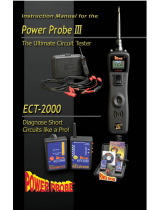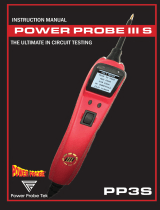
/
11
MODES
The Power Probe III has been designed to work the same as the previous Power Probe circuit testers. Using the ad-
vanced features and modes is optional. However, understanding them will expand your diagnosing capabilities. The
LCD display indicates voltage levels of the circuit along with an identifying symbol showing you what mode it is in. The
additional features contain 5 new modes which give you specific information about how the circuit is reacting.
The 5 Modes can be accessed by depressing the Mode button and cycling through each one.
Mode #1 Power Probe Mode: While the PP3 is in “Power Probe Mode” and the probe tip is floating (not contacting a
circuit), the LCD backlight is on but the display is blank. If the audio tone is turned on you will see a speaker symbol in
the lower right corner of the display. Once you contact the probe tip to a circuit the LCD display will indicate the average
voltage level of the circuit. The red/green polarity indicator (See section Red/Green Polarity Indicator and Audio Tone) will
respond also, showing weather the circuit is positive or negative.
A secondary feature in this mode is the peak to peak threshold detection and signal monitoring. When contacting a signal
generating circuit such as a speaker wire with audio signals on it, the PP3 detects the peak to peak signals and displays
the peak to peak voltage on the display, the sound of the signals will be monitored and heard through the PP3 speaker.
The peak to peak threshold levels are pre-selected by the operator in “Mode 5”. See Mode #5 for more information on set-
ting threshold levels. Placing the PP3 probe tip next to a sparkplug wire (NOT probing it directly), allows you to monitor the
sound of the ignition pulses at the same time display a peak to peak reading The PP3 senses the pulses in ignition wires
through capacitive coupling (DO NOT CONTACT PROBE TIP DIRECTLY TO THE SECONDARY IGNITION CIRCUIT).
By monitoring each plug wire in this way you can locate missing cylinders.
Mode #2 Negative Peak Mode: The Negative Peak Mode monitors a positive circuit and captures the lowest voltage
that it has dropped to. To do this: Place the PP3 in “Negative Peak Mode” by pressing and holding the mode button for 1
second until you hear a low pitched beep and the LCD display indicates a negative (minus) sign in the lower left corner.
The display should also indicate a reading of “0.0” with the probe floating. (This is because no voltage is present). Probe
the positive circuit you want to test and tap the mode button once. The LCD display will show the lowest detected voltage
of the circuit. If the circuit drops in voltage at anytime, a new lowest reading will be captured and displayed. You can then
do a quick tap of the mode button once again to reset the LCD display and indicate the new voltage level on the circuit.
Reset the LCD display by doing a quick tap of the mode button as often as necessary.
An APPLICATION for the use of the “Negative Peak Mode”: Lets say you have a circuit that is suspect of loosing a connec-
tion and the voltage drops, causing something to turn off or malfunction. Probing the circuit and monitoring it in “Negative
Peak Mode” will instantly indicate as the circuit drops in voltage. You can monitor the circuit while wiggling wires and
pulling on connectors to see if the voltage drops. Since the minimum voltage reading is captured and held on the display,
you can inspect it at a later time. You could also perform a battery crank test.
Mode #3 Positive Peak Mode: The “Positive Peak Mode”, monitors the probed circuit and captures the highest detected
voltage. Place the PP3 into “Positive Peak Mode” by pressing and holding the mode button for 1 second until you hear
a beep. Repeat this until you hear a quick high pitched beep and the LCD display indicates a positive (plus) sign in the
lower left corner. The display should also indicate a reading of “0.0” with the probe tip floating. Probe the circuit and the
PP3 instantly displays and holds the highest voltage reading. This means you can remove the probe away from the circuit
and the voltage reading remains displayed for your reference. Reset the LCD display by doing a quick tap of the mode
button.
An APPLICATION for the use of the “Positive Peak Mode”: Let’s say you have a circuit that is supposed to be off and is
suspected of turning on inappropriately or getting a signal for some reason. Probing the circuit and monitoring it in the
“positive peak mode” will instantly indicate as the circuit increases in voltage. You can monitor the circuit while wiggling
wires and pulling on connectors to see if the voltage increases. Since the maximum voltage reading is captured and held
on the display, you can inspect the reading at a later time.
Maybe you have to probe a circuit deep under a dash and the display is obstructed from view. In “Positive Peak Mode” just
probe the wire then remove the probe and look at your voltage reading. Connect to starter terminal to capture maximum
voltage to the starter while cranking. Quickly finds voltage drops in the wiring & start connection (Solenoid).


















